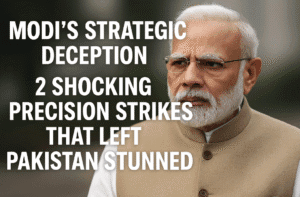Modi’s Strategic Deception: 2 Shocking Precision Strikes That Left Pakistan Stunned
Prime Minister Narendra Modi’s calculated approach during India’s Balakot (2019) and Operation Sindoor (2025) strikes against Pakistan underscores a tactical blend of psychological warfare and disciplined secrecy. By maintaining routine public engagements, avoiding inflammatory rhetoric, and projecting calm, Modi masked military intent, catching Pakistan unprepared both times. Before Balakot, he dedicated a war memorial and delivered economic speeches hours before the strike; ahead of Operation Sindoor, he discussed national aspirations while covertly greenlighting cross-border action.
This deliberate normalcy exploited Pakistan’s cognitive bias linking visible aggression to intent, allowing India to execute precision strikes undetected. Modi’s strategy—rooted in Sun Tzu’s principles of deception—reveals a leadership style prioritizing operational secrecy and narrative control. For adversaries, the lesson is clear: in modern conflict, silence and routine can be deadlier than overt threats. Modi’s success redefines India’s defense playbook, emphasizing unpredictability and strategic patience in a volatile region.

Modi’s Strategic Deception: 2 Shocking Precision Strikes That Left Pakistan Stunned
In the high-stakes arena of geopolitical conflict, leaders often rely on cunning and misdirection to outmaneuver adversaries. Prime Minister Narendra Modi’s orchestration of India’s military responses to cross-border terrorism—the 2019 Balakot airstrike and the recent Operation Sindoor—reveals a masterclass in psychological warfare. By maintaining an unflinching facade of normalcy, Modi’s tactics twice lulled Pakistan into complacency, enabling India to execute precision strikes undetected. This strategic playbook offers profound insights into leadership, deception, and the art of war.
The Balakot Blueprint: Calm Before the Storm
On February 26, 2019, Indian fighter jets crossed into Pakistani airspace to target a terrorist training camp in Balakot. Yet, in the 48 hours preceding the operation, Modi’s public demeanor betrayed no hint of the impending strike.
- Routine Engagements: Just hours before the attack, Modi inaugurated the National War Memorial, emphasizing national pride and military valor without alluding to imminent action. That evening, he delivered a speech at a media summit, discussing economic ambitions and counterterrorism resolve with his trademark composure.
- The Poker Face Principle: Modi’s ability to compartmentalize—separating the gravity of military planning from his public persona—left adversaries and analysts alike in the dark. Psychologists highlight this as a hallmark of crisis leadership: the capacity to project calm while navigating turbulence.
Pakistan, anticipating visible signs of escalation (e.g., heated rhetoric, troop movements), misinterpreted India’s silence as inertia. The result? A stunned adversary and a strategic win for India.
Operation Sindoor: A Repeat Playbook
On May 7, 2025, India launched Operation Sindoor, striking nine terror targets across Pakistan-Occupied Kashmir. Mirroring the Balakot precedent, Modi again masked urgency with routine:
- Business as Usual: Hours before the operation, Modi headlined a public forum, outlining India’s vision to become an economic powerhouse by 2047. His speech, peppered with humor and devoid of Pakistan-focused rhetoric, concealed the military machinery in motion.
- Misdirection Tactics: Announcements of nationwide military drills further misled Pakistan, creating an illusion of prolonged preparation. This “dummy signal” exploited Pakistan’s expectation of conventional escalation timelines, allowing India to strike with tactical surprise.
The Anatomy of Deception: Why It Works
Modi’s success hinges on a blend of Sun Tzu’s timeless principles and modern statecraft:
- Control the Narrative: By avoiding inflammatory language, Modi denied Pakistan propaganda fodder while keeping global舆论 neutral.
- Exploit Cognitive Biases: Humans—and nations—often equate visible activity with intent. Modi’s routine engagements exploited this bias, framing military action as “unthinkable” amid apparent normalcy.
- Secrecy and Discipline: Both operations highlight India’s improved intelligence coordination and airtight operational secrecy—a stark contrast to past leaks that compromised missions.
Lessons for Adversaries and Strategists
- For Pakistan: Failing to adapt to Modi’s tactics after Balakot reflects intelligence and strategic complacency. Modern warfare demands analyzing behavioral patterns, not just physical movements.
- For Leaders: Crisis leadership requires duality—balancing resolve with restraint. Modi’s “nation-first” rhetoric, devoid of jingoism, resonates domestically without alarming international stakeholders.
- For Military Planners: Deception is force multiplier. Misdirection (e.g., announcing drills before strikes) can paralyze an adversary’s decision-making cycle.
The Road Ahead: A New Paradigm in India-Pakistan Relations
Modi’s twin strikes redefine the rules of engagement between the nuclear-armed neighbors. Pakistan, caught off-guard twice, now faces pressure to overhaul its counterintelligence and anticipate non-linear tactics. For India, the challenge lies in sustaining this strategic edge while avoiding overconfidence.
As historian Kaushik Roy notes, “In warfare, the best strategies are those that remain unpredictable.” Modi’s unreadable poker face—a blend of tactical patience and sudden decisiveness—has set a new precedent in South Asia’s volatile theater.
In an era where information travels at lightning speed, Modi’s greatest weapon isn’t stealth jets or missiles—it’s the ability to project normalcy while orchestrating the extraordinary. For Pakistan and the world, it’s a stark reminder: In modern conflict, what you don’t see is often what hurts the most.
You must be logged in to post a comment.